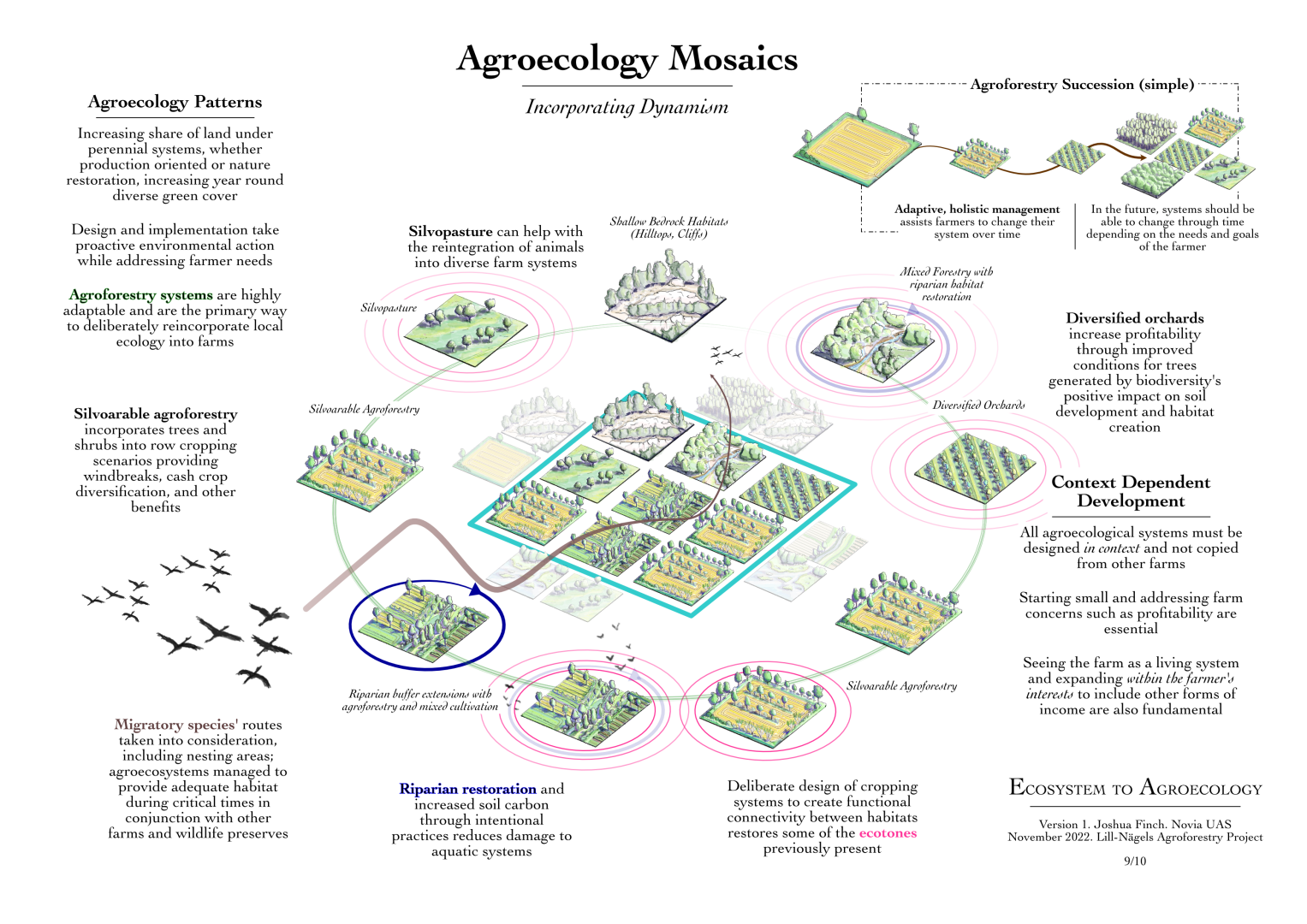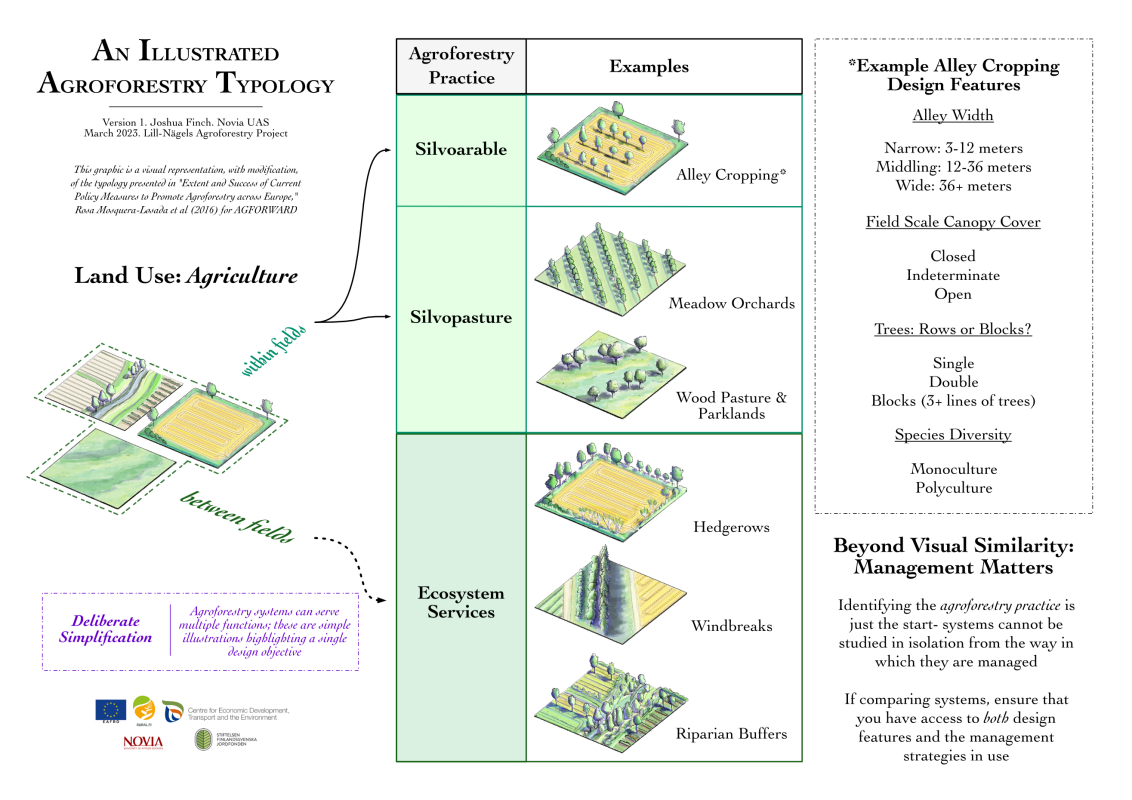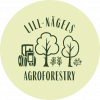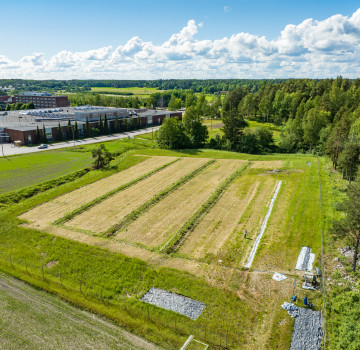Conceptual Background
Here, I'll provide a summary of the project's intentions as well as add chapters on agroecology and agroforestry- two concepts that lie at the heart of why we chose to implement the system we did. Some of the explanations are also posted elsewhere on this site and in articles, but it can be quite useful to collate them here as square one.
Summary: the Lill-Nägels Agroforestry Pilot Project (LillNAP)
This is an updated version of the "summary of the project" we have used when applying for public funds. I think that it does a good job of briefly explaining what it is that we'd like to do. However, due to the nature of summaries, it does not do a good job of explaining what any of these concepts are. Hence this page.
Starting summer 2022, we began to establish a multi-year, field scale (0,8 ha) pilot trial of “successional silvoarable agroforestry” on Lill-Nägels farm in Jorvas, Kirkkonummi. This pilot project will investigate new possibilities of sustainable farm production diversification which address climate change mitigation in the Uusimaa region using experiences from progressive smaller scale silvoarable market garden concepts.
The field we have chosen has been taken out of conventional production and placed into a perennial grass cover due to its poor fertility. This project aims to demonstrate how degraded soils can be simultaneously brought back into production while improving soil and agroecosystem health. Starting from a degraded position should mean that it will be easier to detect beneficial changes due to biological activity and our management of the system.
Today Uusimaa agricultural production mainly relies on monoculture grain production. Our project will trial advanced silvoarable agroforestry practices- including strip cropping in the alleys to mitigate problems with monoculture- which have been demonstrated to increase soil fertility, diversify farm production, and yield important observations for the next generation of these practices which could be scaled to an entire farm.
The project addresses the weak profitability in agriculture overall by investigating the implementation of contemporary alternative cultivation systems (successional agroforestry) on a scale simulating a larger farm. Focusing on whole system design, each component mutually reinforces the other and provides economic benefits from the first full growing season. We intend to participate in the development of machinery to mechanize appropriate work using tools readily available on farms.
Another important aspect is the development and testing of new agricultural practices that generates interest in farming, attracts a younger generation of farmers, students etc that want to develop farming in the future. To engender positive interest is crucial for the future of farming in this region and in Finland on the whole. Part and parcel of this effort is the work to expand the possibilities for direct marketing through community supported agriculture (CSA) models.
What is a Pilot Project?
Before I begin to provide in depth information about the foundational ideas of the project, I think it is especially important to back up even further to explain what a pilot project is and, perhaps, a bit about what it is not. This explanation is necessary because the heterodox (non-conventional) ideas that we are putting into practice do not make much sense outside of a different way of looking at things (a frame of reference or, a "paradigm"). We are intentionally stepping outside of the mainstream approach to agriculture in order to test ideas that we find interesting. We understand that much of what we wish to do with this project is not fully supported by the mainstream: in fact, this is precisely why it is interesting.
So what is a pilot project?
In historical terms, a pilot did not refer to a person flying an airplane. A pilot was something different: a person who understood the local context of a waterbody, especially a harbor, and offered safe passage to locals and visitors alike. A pilot was a guide with enormous responsibility. In our modern era it can be very difficult to understand just how important this job was. In the pre-fossil fuel era, travel by sailing ship was tremendously dangerous and required great skill even in the best of conditions.
Pilots had to know the water like the back of their hands. This meant understanding local variations of tides, how seasonal weather affected sailing, and where shallows, shoals, reefs, oyster beds, and other underwater objects were (perhaps quite aptly, this includes wrecks). They had to continuously update their knowledge as the ocean shifted sandbars and even rocks. Sailors have always known that the map is not the territory: a good chart is a crucial tool, but it is no substitute for current knowledge (pun intended). A pilot who failed put the lives of others at risk as well as any cargo a ship might have been carrying. Why anyone would put their lives and resources at risk by entering the harbor can be answered simply by stating that there was something they believed to be valuable that was worth the risk. Crucially, the risk was mitigated by a skilled pilot.
A pilot project, then, is readily understood in these terms: an idea that holds potential value has been identified, but is not well understood. Larger, less nimble, operations cannot put the concepts to use: the risk is too high. The role of the pilot project is to thoroughly explore the space, make trial runs, and attempt to discover whether the potential value is real value. Perhaps in the course of "piloting" an idea, insurmountable obstacles are identified that prevent the idea, which formally had so much potential value, from being reached and the ideas are abandoned. Or, perhaps, the pilot project is successful and can mark the channels for larger entities to use.
In any case the role of a pilot project is not to ply well-known waters. It is to go where few have gone before and try to make sense of what is found. With this in mind, the LillNAP project is not about declaring right out of the gate that our ideas are fully fledged. We are in the business of growing out a first generation system. The LillNAP project is a rough draft; hopefully, in the future, we will know so much more about how this works that our first attempts will pale in comparison to the systems that come decades from now.
Agroecology and Agroforestry: ideas with lots of potential value
The idea which we believe has lot of value is called agroecology. In the most reductionist sense, agroecology is the application of ecological understanding to agricultural systems. In other words, a farm is an ecosystem: a community of organisms that live in relationship to the land and each other. If a farm is an ecosystem, an agroecology, then it operates with the same processes and dynamics that undergird the evolution of life on earth. These dynamics are hundreds of millions of years in the making and quite sophisticated.
Evidence is accumulating that, when communities of organisms are left to their own devices, that the ability of the ecosystem to host more life, utilize sunlight more efficiently, and survive changes in the environment increases. Is it possible for us to organize our farms so that they mimic natural systems and their tendency to increase in value over time? While not synonymous, regenerative agriculture and agroecology have a lot of overlap. Around the world farmers are sharing their experiences with adapting their farms to become conscious agroecosystems with varying degrees of success.
While many of the benefits of farming this way do not directly translate to economic value (that is, their increase or improved marker is not monetized), together the changes will often improve the farm's overall profitability. Profitability is the key factor in farming within a highly commercialized socioeconomic system, not yield alone. Better profitability comes from improved soil health, which does a better job regulating moisture, making nutrients available to plants through biological pathways (including unlocking nutrients the farmer may have applied in the past, but were made plant-unavailable), and decreasing pest pressure. As farmers are able to reduce the use of outside inputs, they can also decide to utilize technology and knowhow to use other kinds of inputs which support these same forces. Working in ever increasing synergy with life systems and turning a profit sounds very interesting to us.
[

Note: I have a long form lecture series called "Ecosystem to Agroecology" that dives into this topic in a lot more detail which needs some editorial work before it can be posted; above is one of the slides: "Agroecology Mosaics"]
Why is LillNAP an agroforestry project if agroecology is the main idea?
One of the first rules of agroecology or regenerative agriculture is to understand your context. This is one reason why we have spent a significant amount of time detailing the farm's global, regional, and site specific characteristics (see the Site Analysis page under the Field Information heading).
An essential lesson from studying ecology is that most landscapes are inhabited by biologically diverse perennial plant communities. In our part of the world, the kind of ecosystem which tends to take shape is a forest of one kind or another. Woody species, shrubs and trees, simply do well here. Trees- as individuals or communities- provide a lot of ecosystem services which support the healthy function of a resilient landscape.
If the goal is to mimic natural ecosystems, then agroforestry is simply the overarching concept that we should have in mind in our part of the world. Agroforestry, defined simply, is the deliberate inclusion of woody species into agricultural land. Such a definition means agroforestry can mean just about anything. How you choose to bring woody species into your system depends entirely upon your context, which includes not just what region of the world you happen to live in, but also everything from the local field circumstances to available markets and, crucially, the interests of the farmer who will be implementing the system.
Below, I have added "An Illustrated Agroforestry Typology" to help illustrate, in a very impressionistic way, the basic subdivisions of agroforestry as it is applied in an agricultural setting. The Lill-Nägels Agroforestry Project is primarily a "silvoarable" system testing alley cropping, but will likely also include other practices such as hedgerows (around the fields perimeter) and riparian buffer strips (along the bottom of the hill).
 Note: I understand the images are still almost always posting in low resolution and will try to fix this in the near future. Update 20.07.2023: If the image does not display properly, try resizing your browser window to make it larger and smaller, I have found the image will move a few times until it is properly displaying.
Note: I understand the images are still almost always posting in low resolution and will try to fix this in the near future. Update 20.07.2023: If the image does not display properly, try resizing your browser window to make it larger and smaller, I have found the image will move a few times until it is properly displaying.Hopefully this illustration helps give a rough idea as to what the words mean. In practice, things are a lot more complicated, but this should help people who are new to agroforestry comprehend just how many applications agroforestry can have. By no means is this exhaustive either, hence the right hand side of the graphic giving, for just alley cropping, a handful of additional design features you should take into account.
So when we hear about "agroforestry" works or doesn't work, perhaps you will recall this image and ask: "what kind of agroforestry?" Or if you are reading a farmer's report about their project or a peer reviewed article, you can follow the simple flow chart to help understand just what it is you are reading about. I think this is particularly important not to make agroforestry into something that can never be tested, but to help us understand that the concept is vast. Thus, we should be careful about generalizing from one system to another- especially out of context.
Successional Silvoarable Agroforestry
The addition of another adjective to describe our system ties us into how important management is.
Succession refers to the natural change in ecosystems over time, which, in general, appears to move towards increasing complexity.
[In order not to repeat myself too much (and as the site is currently under development), I have written extensively about successional agroforestry in an article about a work study trip regarding the subject. Click here to the Reports & Publication page, then follow the link to the PDF called "Successional Agroforestry Trip to Denmark, October 2022."]

